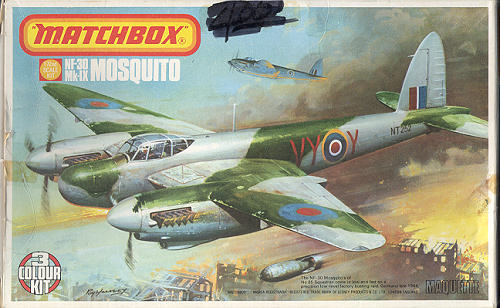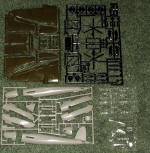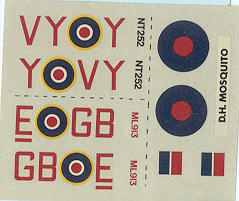
| KIT: | Matchbox 1/72 Mosquito B.IX/NF 30 |
| KIT #: | PK 116 |
| PRICE: | $5-7 or even less at swap meets. Currently OOP |
| DECALS: | Two options |
| REVIEWER: | Scott Van Aken |
| NOTES: | Gotta love the multi-colored plastic! |

| HISTORY |
During WWII, there were very few successful aircraft built from non-strategic materials. One that stands out is the De Havilland Mosquito. With the airframe of wood, it not only allowed aluminum to be used for other aircraft, but also was exceptionally fast. One wonders how much quicker it would have been if made from lighter materials.
Thanks to this speed, the success of the bonding agent for the wood, and the very clean design, the Mosquito went on to be a 'jack of all trades', operating as a fighter, bomber, recce aircraft and night fighter. Later war aircraft were equipped with two stage Merlin engines, allowing greater speed and carrying capabilities. Few survived the war, as much due to the wood construction as anything. These planes were not meant to last more than a few years and it is thanks to the unyielding efforts of enthusiasts that a few are still flying.
| THE KIT |
 You
have to love Matchbox kits. They were originally designed for kid's pocket
money, but many older model builders have fallen under their charms as
well. Two things set these kits apart from others. One is the use of
multi-colored plastic sprues. Undoubtedly this is so that the kiddies don't
have to paint them, but probably just to add to the kid-appeal of the kits.
The other is that most Matchbox kits I've built, have fit very well. Well,
let me broaden that a bit. For a kid, they fit well. The joins are a bit on
the large side and the older modeler will break out the filler for these
and perhaps for the panel lines as well. These are engraved, but rather
large in comparison to today's kits. Besides, the Mossie was a wooden airframe
and had little in the way of panel lines anyway.
You
have to love Matchbox kits. They were originally designed for kid's pocket
money, but many older model builders have fallen under their charms as
well. Two things set these kits apart from others. One is the use of
multi-colored plastic sprues. Undoubtedly this is so that the kiddies don't
have to paint them, but probably just to add to the kid-appeal of the kits.
The other is that most Matchbox kits I've built, have fit very well. Well,
let me broaden that a bit. For a kid, they fit well. The joins are a bit on
the large side and the older modeler will break out the filler for these
and perhaps for the panel lines as well. These are engraved, but rather
large in comparison to today's kits. Besides, the Mossie was a wooden airframe
and had little in the way of panel lines anyway.
Overall detail is not bad, but not
very extensive. You won't find such amenities as a fully detailed cockpit
or boxed in wheel wells. This is a 1970's kit, you know. In fact, the
cockpit really consists of nothing more than a seat shape, control column
and some figures to stick in the seats. An aftermarket etched set is
mandatory for those wanting any detail level at all in the front office.
Transparencies are rather thick, so perhaps any work done on the cockpit
will be wasted without a replacement vac canopy.
The kit can be built as either a bomber variant or a late war night fighter with the centimetric radar. To accommodate those differences, there are two separate noses and since the bomber and fighter versions had different canopies, those are also provided. Another option is the addition of wing fuel tanks or pylons with bombs. Naturally, the night fighter will have the fuel tanks.
Instructions are very much as we all remember with 12 nicely done construction drawings and all painting information at the very end. Color reference are the old Humbrol line so it is good that generic color names are also provided. Markings are for a B.IX from 105 Sq in mid 1943 with green/grey uppers and black undersides. The night fighter is from 85 Sq in late 1944 in overall grey with green upper camo sections. The color painting guide is on the back of the box. I also found the box art to be a bit amusing as I doubt if any night fighters would be dropping bombs during a daylight raid! Nor would they have unshrouded exhaust.
| CONCLUSIONS |
Though this kit has been superseded by those from Hasegawa or Tamiya, the rivet counters have proclaimed those as having inaccuracies sufficient to cause them to writhe on the floor in anguish so I guess this one is OK in terms of shape. It is one of the few two stage Merlin-powered Mossies on the market (perhaps the only one), and still makes into a nice model. Though only sporadically issued by the owner, Revell AG, it isn't difficult to find with a bit of looking.
July 2006
Kit courtesy of my ability to scrounge the vendors at shows.
If you would like your product reviewed fairly and quickly by a site that has nearly 300,000 visitors a month, please contact me or see other details in the Note to Contributors.